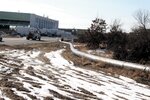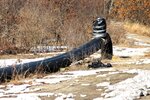By late May those big black pipes snaking down Airport Road and buried at intersections such as Commerce Drive should be gone and a major link in the city’s sewer system conveying about a third …
This item is available in full to subscribers.
We have recently launched a new and improved website. To continue reading, you will need to either log into your subscriber account, or purchase a new subscription.
If you are a current print subscriber, you can set up a free website account by clicking here.
Otherwise, click here to view your options for subscribing.
Please log in to continue |
|



By late May those big black pipes snaking down Airport Road and buried at intersections such as Commerce Drive should be gone and a major link in the city’s sewer system conveying about a third of the waste water carried by city sewers should be fully restored.
Meanwhile, work on the Bayside sewer project, after more than a quarter of century of on-again off-again planning to connect capable sewers to more than 900 properties, is projected to be completed by this September. The full impact of the work won’t come until several months later when the roads of Highland Beach, Bayside, Longmeadow and Riverview are fully repaved.
Combined, the two projects represent $38.9 million of work to major infrastructure that apart from the repaved roads and the disappearance of above ground pipes and construction crews will go virtually unnoticed.
While significant, the restoration of the deteriorating Cedar Swamp forced main that ruptured spilling more than 161,000 gallons of sewage into Warwick Pond on Sept. 13 2022 or the Bayside extension represent only a portion of the ongoing effort to ensure the reliability of a critical community resource and extend it to more neighborhoods. With completion of Bayside, Betty Anne Rogers, executive director of the sewer authority, said about 60 percent of city property owners will have access to sewers.
As a result of being an area that at one time was heavily populated by Native Americans and is rich in Indian and colonial artifacts including burial sites, Bayside sewer construction took a dramatic turn from the open trench construction used throughout the rest of the city. It was the first extensive use of directional drilling that goes below and protects the archeological features of importance to the Narragansett Indians.
Overhaul of sewer policies & programs
But arriving at that means of construction, in fact, building sewers at all, was a decade-long campaign led by Ward 5 Councilman Ed Ladouceur.
In his bid for the council seat, Ladouceur walked the ward multiple times. The lack of sewers was a frequent complaint from homeowners dealing with failing septic systems and overflowing cesspools that in some cases were in violation of clean water protection regulations subjecting them to exorbitant fines. Soon after being elected, Ladouceur created a council review sewer commission bringing together all the stakeholders including governmental and environmental agencies, residents and Native Americans. In fact Doug Harris, representing the Narragansett, was Ladouceur’s first appointment to the commission. The commission’s work took them far beyond Bayside into a revamping of sewer assessments, the examination of septic systems as an alternative to sewers, policies that required the passage of enabling legislation by the General Assembly and approval of $33 million in bonding.
It wasn’t easy and even when Mayor Frank Picozzi allocated $7 million in American Rescue Plan Act funds to establish a $16,900 assessment for the Governor Francis Farms III project along with the O’Donnell Hill and Bayside projects, there was a campaign to stop sewers.
In an interview Saturday, Ladouceur, who broke with city Democrats to endorse Picozzi, an independent for mayor in 2020 noted that Picozzi promised he would do what he could to get Bayside sewers if elected.
“He kept his word,” Ladouceur said.
Had the federal funds not been used, assessments that are based on the overall cost of the project equally divided by the number of property owners benefiting would have been close to $28,000 per homeowner.
With sewer construction entering its third year, Ladouceur said constituents are “getting anxious.” The condition of roads is high on the list of complaints, especially portions of Tidewater Drive. Ironically, as Mat Solitro, of the sewer authority, pointed out, Ladouceur anticipates speeding will become the issue once the roads have been repaved. He’s already a step ahead, however. He said he has requested the purchase of six additional solar operated speed displays that he says have effectively reduced speeding on Warwick Neck Avenue. A couple of them would be mounted on Tidewater Drive.
Although revised regulations provided hardship provisions and an optional low interest rate 30-year assessments, some residents said they would be forced out of their homes and they wouldn’t be able to sell because costs associated with sewers. So far, there have been no reports of that happening.
But the system is comparatively expensive to other neighborhoods, directional drilling and home grinder pumps for a low pressure system pushed costs.
Directional drilling to home owners
About a third of the Bayside project, homes in the Highland Beach area of DelGuidice Park and along the bay will be serviced by sewers installed by open trench construction. D’Ambra Construction has completed that work. Neighborhood roads are scheduled to be repaved this May, Rogers said.
So far, directional drilling service has been completed to about 150 homes, which leaves another 400. Work will resume when asphalt plants reopen in the spring.
On the financial end, Solitro said material costs have evened out and supply lines have reopened. The D’Ambra contract has an asphalt-diesel escalator that is adjusted with the cost of those materials. So far, fortunately, inflation has slackened and the overall additional cost of the D’Ambra contract is about $17,000. D’Ambra’s contract is approximately $18 million with the overall Bayside sewer project coming to $25 million when calculating the archeological surveys, engineering, temporary repaving and system design.
“We’re definitely getting to the end of the tunnel,” Ladouceur said of the project. He praised D’Ambra for responding to the needs of homeowners and for making the work the least disruptive as possible.
With the resumption of work, Rogers expects an increase in inquiries about connections. Two homes have already been connected to the system. Assessments won’t be mailed until the full Bayside project is completed. As the authority issues assessments twice a year, she said that could happen in September or in April 2025.
The authority brings the connecting pipe to the preferred location (other utilities such as gas and water lines can play a role in the location) and from there the homeowner is responsible for retaining a drain layer to install the grinder pump and make the connections. The pumps are provided by the authority and are included as part of the assessment.
Building a pipe within a pipe
The relining of the Cedar Swamp pressure line, involves an entirely different process than installing new lines whether with directional drilling or open cuts. The first step to the work being done by Green Mountain Pipeline Services was the installation of a bypass to the underground pipes- all those big black pipes. The next step was to clean and carefully inspected the pipe underground for breaks and severe deterioration from the corrosive effects of hydrogen gas build ups. Pits are dug to expose sections of the underground pipe to start the process of lining it with fiberglass that is resistant to corrosive gases. This is accomplished by inserting a resin soaked sleeve or sock into the pipe and expanding it to diameter of the pipe under the pressure of hot water. The hot water is a catalyst triggering the curing of the fiberglass.
The project was initially estimated at about $4 million, but when the low bid came in at nearly $14 million, the authority stepped back to reassess. As it turned out the two low bids were within $20,000 of each other. Then it became an issue of money. The City Council granted the authority additional bonding that it obtained with a Clean Water Loan through the Rhode Island Infrastructure Bank.
Will it impact sewer fees?
So, how is the authority going to pay back all this money? In the case of Bayside, assessments plus the $7 million in ARPA funds will pick up the costs. The Cedar Swamp forced main is a restoration project that benefits the entire system. The water tanks on Bald Hill Road with a reserve of 12 million gallons is a fair analogy, although waster water and drinking water is not. Repairs to those tanks were essential to the integrity of the system. The money came from division reserves and bonds. In other words user rates, whether held in reserves or paid in installments.
The question is can the authority make these infrastructure improvements, which are critical to maintaining efficient dependable services at an affordable cost to the users?
In the short term, Rogers is aiming to make that happen.
She said authority account David Bebyn has completed a study of authority debt showing that with the retirement prior bond issues, the authority should be able to carry the new debt without impacting rates. A critical factor is the number of users. The greater the number of users, the more people share in the cost and the less it is for everyone.
Warwick does not mandate sewer connections, other than when a property with a dysfunctional septic system or cesspool is sold or a connect capable fee as an incentive to homeowners to tie into sewers. Nonetheless, expansion of the system, like Bayside, not only enhances the environment but makes it affordable to flush toilets.
Comments
No comments on this item Please log in to comment by clicking here